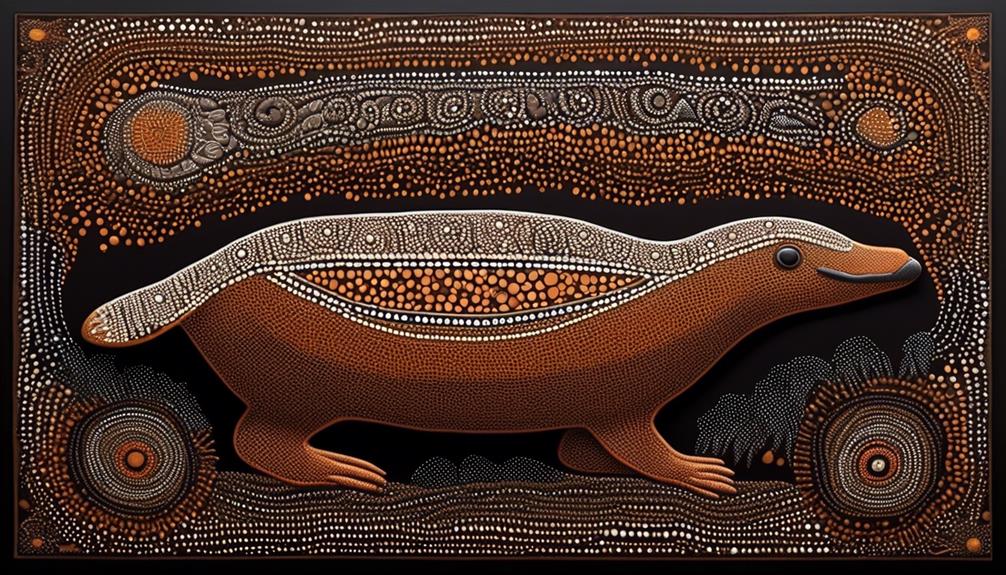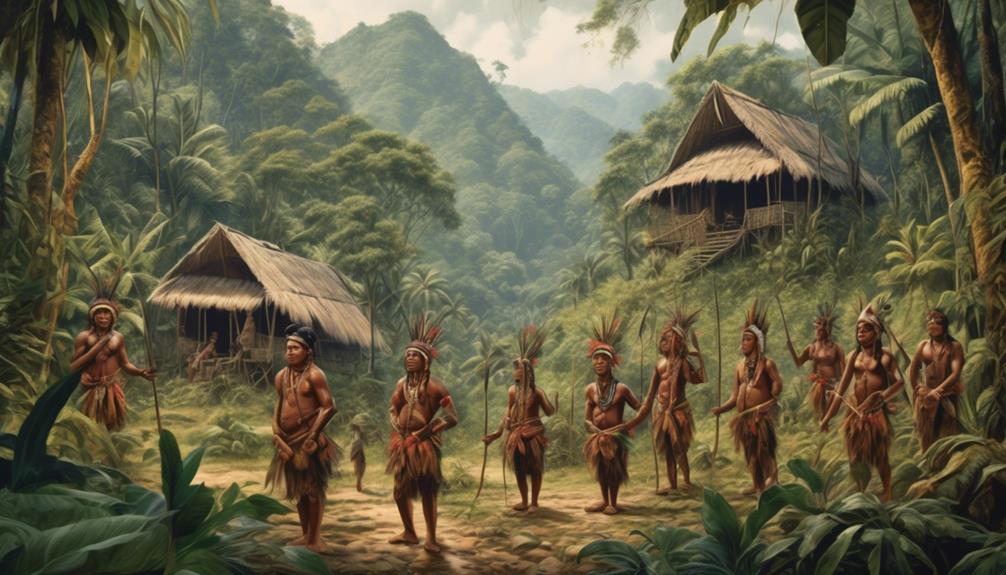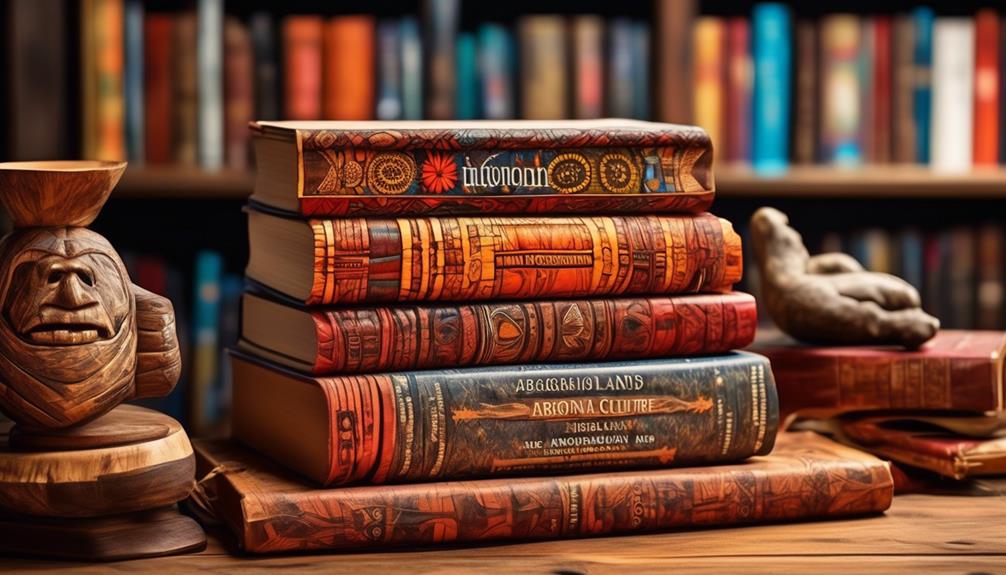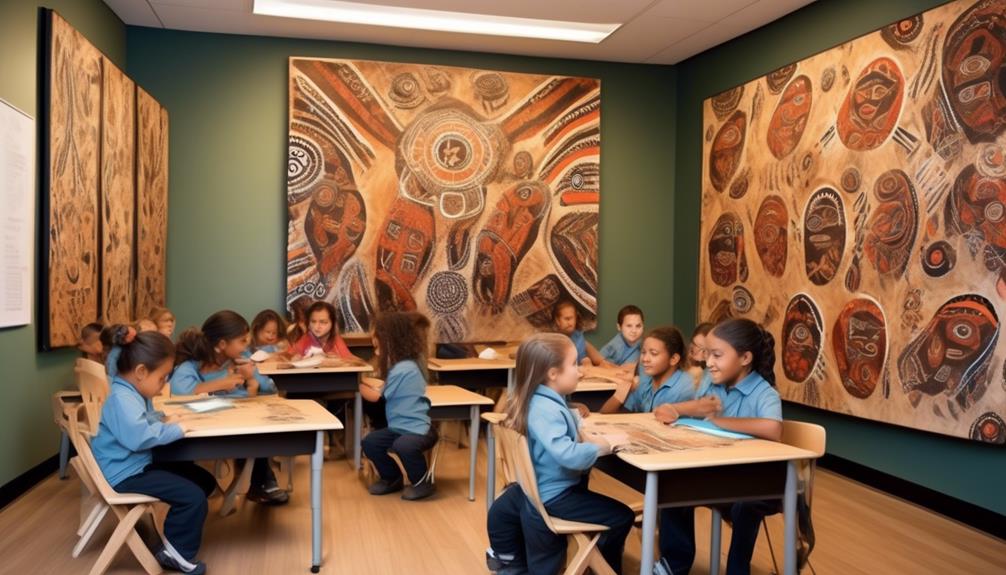The well-known saying, “A picture is worth a thousand words,” takes on a whole new meaning with Aboriginal Dot Painting.
The intricate patterns and vibrant colors of these paintings have been captivating audiences for generations, but there's much more to them than meets the eye.
From their origins steeped in tradition to their modern-day impact, Aboriginal Dot Painting holds a rich tapestry of stories, techniques, and cultural significance.
It's a form of art that not only showcases incredible talent but also serves as a window into the beliefs and narratives of a people with a profound connection to their land and heritage.
Key Takeaways
- Aboriginal dot painting is a traditional art form that originated from the Indigenous cultures of Australia and holds significant cultural and spiritual importance to the Aboriginal people.
- The techniques and tools used in Aboriginal dot painting have been passed down through generations, with artists using natural brushes, sticks, feathers, and their hands to create intricate patterns and layers of dots.
- Aboriginal dot paintings depict Dreamtime stories, which are ancient stories that connect Aboriginal people to the land and their cultural identity. Each dot, line, and symbol in the paintings holds specific meanings and reflects the spiritual significance of the natural environment.
- Aboriginal dot painting has evolved over time and now incorporates contemporary interpretations and influences. It is displayed in galleries and museums worldwide, attracting a wider audience and fostering cross-cultural understanding. The art form also serves as a medium for preserving and sharing Indigenous stories and traditions.
Origins of Dot Painting
The origins of dot painting can be traced back to the indigenous cultures of Australia, where it was traditionally used for storytelling and ceremonial purposes. This unique art form is deeply rooted in the cultural heritage of the Aboriginal people, dating back tens of thousands of years. The techniques used in dot painting are passed down through generations, with each artist adding their own personal touch while staying true to the traditional methods.
The use of dots in Aboriginal art carries significant cultural symbolism. Each dot represents a story, an aspect of the land, or a ceremonial significance. The placement, size, and color of the dots are carefully chosen to convey specific meanings. For example, different regions of Australia have distinct dot painting styles, each reflecting the natural environment and cultural practices of the area.
In modern times, dot painting has evolved beyond its traditional ceremonial role. While still deeply rooted in cultural significance, contemporary artists have adapted the art form to express a wide range of themes, from historical narratives to contemporary social and political issues. This modern interpretation of dot painting continues to honor its cultural origins while also serving as a form of artistic liberation and expression for Indigenous artists.
The evolution of dot painting reflects the resilience and creativity of Aboriginal cultures, as they continue to celebrate their heritage and adapt to the complexities of the modern world.
Symbolism and Meaning

Symbolism and meaning in Aboriginal dot painting are intricately woven into the intricate patterns of dots, each conveying rich cultural narratives and deep spiritual significance. The traditional art form carries profound symbolism, reflecting the interconnectedness of indigenous culture with the land, spirituality, and ancestral knowledge.
- Dreamtime Stories: The dots in Aboriginal dot paintings often represent stories from the Dreamtime, the period of creation in indigenous Australian belief systems. These stories recount the journeys of ancestral beings and their transformative actions, providing a spiritual and moral framework for Aboriginal life.
- Connection to Country: The placement and arrangement of dots can symbolize specific landscapes, waterholes, or significant sites within the Aboriginal people's traditional territories. Through these depictions, the artworks serve as a visual record of the deep connection between the artists and their ancestral lands.
- Ceremonial Significance: Many dot paintings are created for ceremonial purposes, and the symbols within them often hold ritual significance. The dots may encode secret or sacred knowledge, acting as a visual language that's understood by those within the indigenous community.
The meaning embedded in Aboriginal dot paintings transcends mere aesthetic appeal, encapsulating the essence of indigenous identity, spirituality, and cultural heritage. These artworks aren't just decorative; they're powerful conduits for preserving and transmitting the wisdom and traditions of Australia's First Nations peoples.
Traditional Techniques
When exploring the traditional techniques of Aboriginal dot painting, it's essential to examine the tools used and the symbolism and meaning behind the intricate dots.
The use of specific tools, such as natural brushes and sticks, played a crucial role in the creation of these artworks, allowing for the precise and intricate application of the dots.
Additionally, understanding the symbolism and meaning behind the dots unveils the rich cultural and historical significance embedded in these traditional techniques.
Dot Painting Tools
Using finely crafted tools such as sticks, feathers, and even the artist's own hands, Aboriginal dot painting is created through a meticulous process of layering and stippling.
The traditional techniques employed in dot painting reflect the cultural preservation of Indigenous Australian art forms, keeping alive the rich history and traditions of the Aboriginal people.
The dotting tools used in this art form are essential for creating intricate patterns and designs, each carrying deep symbolism and meaning.
These tools, passed down through generations, are a testament to the continuity of Indigenous artistic practices and the preservation of cultural identity.
Through contemporary interpretations, these traditional dot painting tools continue to be utilized, allowing for the expression of ancient stories and spiritual connections to the land in a modern context.
- Sticks
- Feathers
- Artist's hands
Symbolism and Meaning
The meticulous process of layering and stippling with finely crafted tools, such as sticks, feathers, and the artist's own hands, in Aboriginal dot painting not only reflects the cultural preservation of Indigenous Australian art forms but also carries deep symbolism and meaning through traditional techniques.
The symbols and patterns in dot paintings aren't just decorative; they convey stories of the land, ancient rituals, and the Dreamtime. Each dot and its placement holds significance, representing elements like waterholes, ceremonial sites, or ancestral tracks.
The interpretation of these symbols requires an understanding of Indigenous cultural knowledge and traditions. Through Indigenous art appreciation, one can delve into the rich tapestry of meanings woven into these paintings, gaining insight into the spiritual and historical significance they hold for Aboriginal communities.
Understanding the symbolism in dot painting is a profound way to appreciate and respect Indigenous culture.
Significance in Aboriginal Culture

Significance in Aboriginal culture is deeply rooted in the spiritual and ceremonial traditions of the indigenous peoples of Australia. Aboriginal dot painting holds a profound significance in their cultural heritage, serving as a form of artistic expression that encapsulates the stories, beliefs, and rituals of their ancestors.
The importance of this art form can be understood through the following points:
- Connection to Ancestral Spirits: Aboriginal dot painting isn't merely a visual art form but a means of connecting with the ancestral spirits and the land. The intricate patterns and symbols depicted in the paintings are often associated with Dreamtime stories, which are the foundation of Aboriginal spirituality and belief systems.
- Preservation of Knowledge: Through the intricate dots and symbols, Aboriginal dot paintings serve as a way of preserving and transmitting cultural knowledge. Each painting carries layers of meaning, encapsulating ancient wisdom, traditions, and rituals that are passed down through generations.
- Ceremonial Importance: These paintings are often created as part of ceremonial rituals, where the act of painting itself is a sacred and spiritual practice. The process of creating these artworks is deeply intertwined with ceremonial practices, symbolizing the continuity of cultural traditions and the connection to the spiritual realm.
The significance of Aboriginal dot painting in their culture goes beyond mere artistic expression; it's a spiritual practice, a medium for storytelling, and a way of preserving their cultural heritage for future generations.
Stories and Narratives

Stories and narratives depicted in Aboriginal dot paintings serve as a vivid portrayal of the cultural heritage and spiritual beliefs of the indigenous peoples of Australia, encompassing the essence of their ancestral traditions and wisdom. These paintings aren't just decorative; they're a medium through which the Aboriginal people communicate and preserve their stories, identity, and knowledge. Each dot, line, and symbol in the artwork holds a specific meaning and is often used to represent elements from creation stories, dreamtime narratives, and everyday life. The intricate patterns and symbols in the paintings aren't only visually captivating but also hold deep spiritual and cultural significance.
Artistic techniques and traditions are deeply intertwined with the storytelling aspect of Aboriginal dot paintings. The artists use natural pigments and colors derived from the earth, and the application of dots and lines isn't just a technique but a way of encoding and preserving sacred knowledge. The process of creating these paintings is often passed down through generations, and each artist brings their own interpretation and experiences into the artwork, adding layers of complexity and richness to the narratives being depicted.
These stories and narratives are essential in understanding the cultural and spiritual landscape of the Aboriginal people. They provide a window into their worldview, beliefs, and values, and are a powerful assertion of their continued presence and resilience. The stories depicted in these paintings aren't static; they evolve and adapt, reflecting the ongoing connection of the Aboriginal people to their land, spirituality, and traditions.
Connection to the Land

The Aboriginal dot paintings have a deep connection to the land, reflecting the spiritual significance of the natural environment to Indigenous Australian culture. These artworks often depict Dreamtime stories that are intrinsically linked to the land, serving as a visual representation of the ancestral connections and mythology passed down through generations.
The intricate dots and symbols in the paintings not only convey artistic expression but also carry the essence of the land and its sacred stories.
Spiritual Significance of Land
Nestled within the rich traditions of Aboriginal culture, the spiritual connection to the land is a profound and integral aspect of our worldview. This connection is deeply rooted in our history and shapes our identity as Aboriginal people.
The spiritual significance of the land is manifested through various traditional practices and beliefs, including:
- Dreamtime stories that explain the creation of the land and its features
- Sacred sites that hold immense spiritual value and are central to our cultural practices
- Rituals and ceremonies that honor the land and maintain our spiritual connection to it
These elements illustrate the intricate relationship between Aboriginal people and the land, showcasing the spiritual connection and traditional artistry that have been passed down through generations.
Understanding the spiritual significance of the land is crucial for appreciating the depth of Aboriginal culture and its enduring connection to the environment.
Dreamtime Stories and Land
Rooted in our cultural heritage, the profound spiritual connection to the land is intricately woven into the fabric of Aboriginal existence, shaping our worldview and guiding our understanding of the Dreamtime Stories and their profound link to the land.
Dreamtime stories serve as a spiritual map, depicting the creation of the land, its features, and the ancestral beings that shaped it. These stories aren't only narratives but also a guide, connecting us to the land and its significance in our cultural identity.
The Dreamtime stories convey the intimate relationship between the land and our spirituality, emphasizing the interconnectedness of all living beings. Through these stories, we understand our responsibility to protect and preserve the land, as it isn't just physical space but a living entity, sustaining our existence and embodying our spiritual connection to the earth.
Evolution of Dot Painting

As Aboriginal dot painting emerged, it underwent a significant evolution, reflecting the cultural and historical shifts of Indigenous communities. This artistic evolution has been a dynamic process, influenced by traditional techniques, cultural evolution, and modern interpretations.
- Traditional Techniques: The evolution of dot painting has seen a continuation of traditional techniques passed down through generations. Artists have embraced the use of natural pigments, traditional symbols, and storytelling methods, maintaining a connection to their cultural roots while adapting to contemporary contexts.
- Artistic Evolution: Over time, dot painting has evolved from being exclusively associated with sacred ceremonies and rituals to being displayed in galleries and museums worldwide. This evolution has allowed for the exploration of new themes and styles, while still retaining the essence of storytelling and connection to the land.
- Modern Interpretations: The evolution of dot painting has also seen artists incorporating modern interpretations and influences into their work. From urban Indigenous artists to those living in remote communities, the incorporation of contemporary issues and experiences has added layers of complexity and relevance to the art form.
The evolution of dot painting stands as a testament to the resilience and adaptability of Indigenous artistic expression. It hasn't only preserved traditional practices but has also allowed for the exploration of new creative territories, reflecting the ongoing vitality of Indigenous cultures.
Cultural Preservation

As we explore the significance of Aboriginal dot painting, it's essential to recognize the role it plays in preserving artistic traditions and conserving cultural symbolism.
The intricate dot patterns and symbols in these artworks carry deep cultural meanings and stories, serving as a crucial method of passing down traditions and conveying cultural knowledge.
Artistic Tradition Preservation
The preservation of artistic traditions, such as the intricate dot painting technique of Aboriginal art, is essential for safeguarding cultural heritage and promoting intergenerational knowledge transfer. The continuation of these traditions relies on the implementation of preservation techniques and the encouragement of artistic interpretation.
- Revitalizing Techniques: Utilizing modern conservation methods to ensure the longevity of traditional artworks.
- Community Involvement: Engaging Aboriginal communities in the preservation process to maintain authenticity and cultural significance.
- Education Initiatives: Developing programs to educate younger generations about the historical and cultural importance of Aboriginal artistic traditions.
These initiatives not only serve to protect the integrity of Aboriginal art but also contribute to the broader narrative of cultural preservation and the celebration of diverse artistic legacies.
Cultural Symbolism Conservation
In the conservation of cultural symbolism within Aboriginal dot painting, the intricate meanings and historical significance of the symbols are meticulously preserved to ensure the continuation of rich cultural narratives.
This preservation is crucial for safeguarding the cultural heritage and traditional artistic expression of Aboriginal communities.
Each symbol holds profound significance, often representing ancestral stories, spiritual beliefs, and connection to the land.
By conserving these symbols, we honor the resilience and wisdom of the Aboriginal people, preserving a vital part of their identity for future generations.
Through this dedicated preservation, the essence of Aboriginal culture remains alive, fostering a deep appreciation for the diversity of human expression and the enduring power of storytelling through art.
It's a testament to the strength and resilience of the Aboriginal community that these cultural symbols continue to thrive amidst the complexities of the modern world.
Tools and Materials
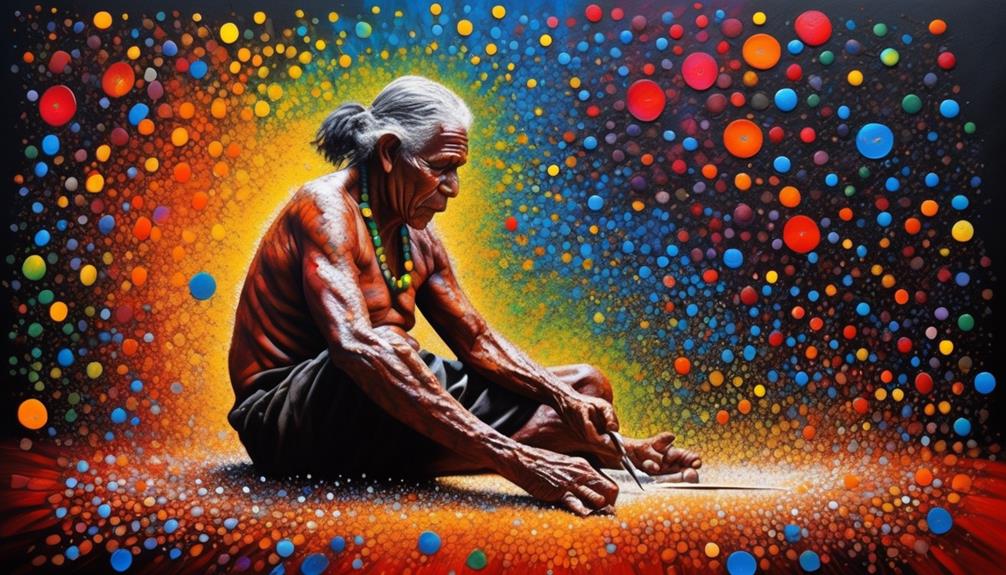
Using a variety of natural materials such as ochre, charcoal, and natural pigments, Aboriginal artists create dot paintings that hold deep cultural and spiritual significance. These traditional materials are gathered from the land and hold great importance in Aboriginal culture. The techniques used in dot painting have been passed down through generations, connecting contemporary interpretations with ancient traditions.
- Traditional Tools: Aboriginal artists use a variety of tools to create dot paintings, including sticks, handmade brushes, and even their bare hands. These tools are carefully chosen to achieve the desired dot size and texture, showcasing the artists' skill and precision.
- Natural Pigments: The use of natural pigments such as ochre is a crucial aspect of dot painting. These pigments are sourced from the earth and carry spiritual significance, connecting the artwork to the land and its stories.
- Contemporary Adaptations: While traditional tools and materials remain fundamental to dot painting, contemporary artists have also explored new techniques and pigments. This fusion of old and new allows for the continued evolution of dot painting while honoring its cultural roots.
The significance of these tools and materials extends beyond the physical act of painting; it embodies the deep connection between the artists, their culture, and the land. Through the use of traditional materials and techniques, Aboriginal dot paintings continue to serve as a powerful expression of identity and storytelling, both preserving and evolving the rich cultural heritage of the Aboriginal peoples.
Contemporary Interpretations

Exploring contemporary adaptations and reinterpretations of Aboriginal dot painting reveals the dynamic evolution of this traditional art form. Indigenous art, including dot painting, has undergone a fascinating transformation in response to modern societal impact. Contemporary interpretations of this art form not only showcase the resilience and adaptability of Indigenous cultures but also serve as a means of cultural symbolism preservation.
| Contemporary Interpretations | Description | Impact |
|---|---|---|
| Fusion with Modern Techniques | Incorporating new tools and materials | Widening audience appeal |
| Exploration of New Themes | Addressing contemporary issues | Bridging traditional and modern narratives |
| Collaborations with Artists | Partnering with non-Indigenous artists | Fostering cross-cultural understanding |
The evolution of Indigenous art is a testament to its enduring significance. Artists are infusing traditional dot painting with modern techniques, such as using acrylic paints and canvas, to both preserve cultural symbolism and attract a wider audience. Moreover, the themes explored in contemporary dot paintings reflect the intersection of traditional Indigenous culture and modern realities, effectively conveying the ongoing relevance of this art form. Collaborations between Indigenous and non-Indigenous artists not only enrich the creative process but also foster cross-cultural understanding, contributing to the evolution of Indigenous art in a global context.
Regional Styles

As we explore the regional styles of Aboriginal dot painting, we'll examine the symbolism inherent in these artworks, the techniques and materials utilized, and their cultural significance.
Each region of Australia has its own distinct style and interpretation, reflecting the unique stories and traditions of the indigenous peoples. By delving into the regional variations, we gain a deeper understanding of the diversity and richness of Aboriginal art.
Symbolism in Dot Painting
Dot painting, a traditional Aboriginal art form characterized by the use of intricate patterns of dots, holds deep cultural and spiritual significance across various regional styles. When exploring the symbolism in dot paintings, it's essential to consider the technique evolution, spiritual connection, and contemporary interpretations.
- Technique Evolution: The evolution of dot painting techniques reflects the adaptation and innovation within different Aboriginal communities, showcasing the diversity and creativity of the art form.
- Spiritual Connection: The symbolism in dot paintings often represents ancestral stories, sacred rituals, and connections to the land, serving as a visual language to communicate cultural heritage and spiritual beliefs.
- Contemporary Interpretations: In contemporary Aboriginal art, dot painting continues to evolve, blending traditional symbolism with modern influences, reflecting the ongoing resilience and creativity of Indigenous communities.
Understanding the symbolism in dot painting unveils a rich tapestry of cultural expression and storytelling, rooted in tradition yet ever-evolving.
Techniques and Materials
In Aboriginal dot painting, the techniques and materials used vary significantly across different regional styles, reflecting the diverse cultural and artistic expressions within Indigenous communities.
Traditional techniques involve the use of natural pigments derived from plants, flowers, and earth, which are ground into a fine powder and mixed with a binding agent such as water or animal fat. These pigments are then applied to the painting surface using various dot painting tools, such as thin sticks, reed brushes, or even the artist's own fingers.
The application of these dots isn't merely decorative but carries deep cultural and spiritual significance, often representing elements of the natural world, ancestral stories, and sacred rituals.
Each regional style employs distinct techniques and tools, showcasing the rich and varied artistic traditions of Aboriginal dot painting.
Cultural Significance
The diverse regional styles of Aboriginal dot painting reflect the deep cultural and spiritual significance embedded within the techniques and materials used, illustrating the rich artistic traditions of Indigenous communities.
- Interconnectedness: Each regional style of dot painting encapsulates the interconnectedness between the land, the people, and their ancestral stories, portraying a deep spiritual connection to the natural world.
- Cultural Heritage: These regional styles serve as a living testament to the rich cultural heritage of Aboriginal communities, preserving and sharing their traditional stories, ceremonies, and knowledge through artistic expression.
- Artistic Evolution: The evolution of regional styles over time mirrors the resilience and adaptability of Indigenous cultures, showcasing how artistic traditions continue to thrive and adapt to contemporary contexts while maintaining their cultural authenticity.
Dot Painting Process

Using traditional ochre pigments, Aboriginal artists apply meticulous dots to create intricate patterns and stories in their dot paintings. Dot painting techniques have been passed down through generations, evolving alongside the Aboriginal culture and art forms.
The process begins with the preparation of natural ochre pigments, which are ground into a fine powder and mixed with a binding agent to form a paint. The artist then uses a variety of tools such as sticks, handmade brushes, or even their hands to apply the dots onto the canvas or surface. The size and spacing of the dots are crucial in conveying the stories and symbols depicted in the artwork. Each dot is carefully placed to form intricate patterns that hold deep cultural and spiritual significance.
The dot painting process isn't merely a decorative technique; it serves as a medium for storytelling, conveying ancestral knowledge, and preserving cultural traditions. As the Aboriginal art evolved over time, dot painting became a powerful means of expressing connections to the land, the Dreamtime, and the natural world. The meticulous application of dots reflects the intimate relationship between the artist and the subject matter, capturing the essence of the stories being told.
This method of painting is a testament to the resilience and creativity of Aboriginal peoples, as they've adapted traditional techniques to continue sharing their rich cultural heritage with the world.
Cultural Significance

Evidently, the dot painting technique holds immense cultural significance for Aboriginal communities, serving as a conduit for storytelling, spiritual expression, and the preservation of ancestral knowledge. This ancient artistic expression reflects the deep-rooted cultural practices of the Aboriginal people, encapsulating their profound connection to the land, the Dreamtime, and their rich cultural heritage. The intricate dot patterns not only convey mesmerizing visual narratives but also carry layers of symbolic meaning, making them a vital aspect of Aboriginal artistic expression.
- Storytelling: Dot painting serves as a visual medium through which stories of creation, important events, and cultural traditions are passed down through generations. Each dot and symbol in the artwork represents a specific aspect of these narratives, weaving together a tapestry of history and knowledge.
- Spiritual Expression: The act of creating dot paintings is a spiritual process, with artists often entering a meditative state as they meticulously apply each dot. This meditative practice is a way of connecting with the spiritual realm and paying homage to the ancestors.
- Preservation of Ancestral Knowledge: Through the continuation of this traditional artistic practice, Aboriginal communities uphold their ancestral knowledge and cultural identity. Dot paintings aren't merely decorative; they serve as a means of preserving and perpetuating the wisdom and customs of the past.
The cultural significance of dot painting transcends its aesthetic appeal, embodying a legacy of resilience, spirituality, and cultural continuity within Aboriginal communities.
Dot Painting in Modern Society

As we transition into the modern era, dot painting has evolved from a traditional Aboriginal artistic practice to a globally recognized art form with diverse applications and interpretations. In contemporary society, Aboriginal dot painting continues to thrive, adapting to new contexts while preserving its cultural significance. Modern interpretations of dot painting encompass a wide range of themes, from traditional stories and ceremonial practices to contemporary issues and personal expressions. This evolution has allowed for the cultural preservation of Aboriginal traditions while also embracing innovation and change.
Contemporary techniques have expanded the possibilities of dot painting, with artists experimenting with new materials, tools, and styles. The use of acrylic paints and canvas, for example, has enabled artists to create larger and more durable works suited for public display and commercial purposes. Additionally, the incorporation of different brush sizes and textures has added depth and complexity to the dotting process, leading to a diverse array of regional styles within the broader category of dot painting. These developments haven't only sustained the practice of dot painting but also propelled it into the forefront of modern Indigenous art.
The modern era has also seen the global recognition of Aboriginal dot painting, with works being exhibited in prestigious galleries, museums, and international art fairs. This widespread acclaim hasn't only elevated the status of Indigenous artists but has also fostered cross-cultural appreciation and understanding. As we continue to embrace the richness of Aboriginal dot painting in the modern world, its enduring legacy remains a testament to the resilience and creativity of Indigenous peoples.
Impact and Recognition

The global impact of Aboriginal dot painting has led to widespread recognition of its cultural significance and artistic innovation. This recognition has permeated contemporary society, influencing various aspects of art, culture, and indigenous rights. The impact and recognition of this indigenous art form are undeniable, and its significance continues to grow in the modern world.
- Recognition of Cultural Heritage: Aboriginal dot painting has gained recognition as a vital part of Australia's cultural heritage, not just by the indigenous communities but also by the broader Australian society and the world. Its unique style and storytelling through symbols have contributed to its recognition as a significant cultural art form.
- Influence on Contemporary Art: The impact of Aboriginal dot painting on contemporary art is evident, with many artists and art movements drawing inspiration from its techniques and motifs. This influence has helped bridge the gap between indigenous art and the broader art world, leading to a greater appreciation of indigenous artistic innovation.
- Advocacy for Indigenous Rights: The recognition of Aboriginal dot painting has also played a role in advocating for indigenous rights and autonomy. By acknowledging the cultural and artistic significance of this art form, society has taken steps towards acknowledging and respecting indigenous communities and their contributions to the world.
Frequently Asked Questions
How Do Different Aboriginal Communities Incorporate Their Own Unique Cultural Stories and Symbols Into Dot Painting?
Incorporating symbols and cultural storytelling is vital for preserving traditional techniques. Community involvement is key to ensuring the continuation of these rich artistic practices.
Different Aboriginal communities embrace their unique stories and symbols through dot painting, showcasing their diverse cultural heritage. The incorporation of these elements not only adds depth and meaning to the artwork but also serves as a powerful form of cultural expression and preservation.
What Role Do Elders and Community Leaders Play in Preserving and Passing Down Traditional Dot Painting Techniques?
Elders hold a critical role in preserving and passing down traditional techniques. Their wisdom and guidance are invaluable in maintaining our cultural heritage.
Community leaders also play a pivotal role in ensuring that these practices are upheld and shared with future generations. Their dedication to cultural incorporation fosters a sense of belonging and pride within the community.
The significance of their contributions can't be overstated in safeguarding our traditions.
How Has the Popularity of Dot Painting in Modern Society Impacted the Economic and Cultural Well-Being of Aboriginal Communities?
The popularity of dot painting in modern society has significantly impacted the economic and cultural well-being of Aboriginal communities. This art form's increased demand has led to economic opportunities for artists and their communities.
However, it has also raised concerns about cultural appropriation and the preservation of traditional techniques. As a result, we must carefully navigate the balance between economic benefits and the preservation of indigenous traditions.
To ensure the continued cultural and artistic integrity of dot painting, it is important to address these concerns and work towards a solution that respects and supports Aboriginal artists. This can involve establishing guidelines for the ethical production and sale of dot paintings, as well as providing support for artists to continue practicing and passing down traditional techniques.
What Are Some Common Misconceptions About Dot Painting and Its Cultural Significance That You Would Like to Address?
Misconceptions about dot painting often overlook its cultural significance. Incorporating stories and traditional techniques, it holds deep spiritual and historical value for Aboriginal communities.
One interesting statistic is that over 85% of dot paintings sold are fake, perpetuating misconceptions about this sacred art form.
Recognizing and respecting the cultural significance of dot painting is vital for dispelling these misconceptions and supporting the economic and cultural well-being of Aboriginal communities.
Are There Specific Initiatives or Organizations Working to Ensure the Continued Recognition and Appreciation of Aboriginal Dot Painting as a Significant Art Form?
There are numerous initiatives and organizations dedicated to preserving and promoting the cultural recognition and artistic expression of various indigenous art forms.
These preservation efforts are crucial for ensuring the continued recognition and appreciation of these significant art forms.
Through these initiatives, the rich cultural heritage and artistic traditions are celebrated, providing a platform for indigenous artists to showcase their talents and contribute to the broader artistic landscape.
Conclusion
In conclusion, we've learned that Aboriginal dot painting is more than just dots on a canvas. It's a rich tradition filled with symbolism and meaning, passed down through generations.
The process itself is a labor of love, with each dot telling a story. And in modern society, it continues to make an impact and gain recognition.
So next time you see a dot painting, remember, it's not just a bunch of dots – it's a whole world of culture and history.


